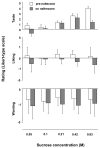Depot naltrexone decreases rewarding properties of sugar in patients with opioid dependence
- PMID: 21960180
- PMCID: PMC3302938
- DOI: 10.1007/s00213-011-2503-1
Depot naltrexone decreases rewarding properties of sugar in patients with opioid dependence
Abstract
Background: Opioid neurotransmission mediates hedonic value of sweet tastants; their intake may be exaggerated by the consumption of exogenous opioids (e.g., opioid dependence). Sweet Taste Test (STT) is a validated quantitative instrument assessing taste perception and hedonic features of sugar (sucrose) using a randomized and double-blind administration at five different sucrose concentrations ranging from 0.05 to 0.83 M.
Methods: The STT and cue-induced craving procedure were administered to opioid-dependent patients (n = 15) before and 1 week after the injection of a long-acting depot naltrexone (XRNT) preparation.
Results: Analyses of covariance, employing sucrose concentration and its perceived taste as covariates, showed that XRNT therapy significantly reduced the self-reported hedonic and motivational characteristics of sucrose. Greater reductions in both these characteristics were associated with more diminution in the cue-induced opioid craving.
Conclusions: Opioid antagonism in opioid-dependent subjects leads to a smaller sweet taste reward, which, in turn, may be proportional to decreased opioid craving. These pilot results support the heuristic value of the STT as a potential marker of the XRNT treatment response and call for further inquiry into potential clinical applications of the test.
Figures


Similar articles
-
Endogenous opioids are necessary for benzodiazepine palatability enhancement: naltrexone blocks diazepam-induced increase of sucrose-'liking'.Pharmacol Biochem Behav. 2005 Jul;81(3):657-63. doi: 10.1016/j.pbb.2005.05.006. Pharmacol Biochem Behav. 2005. PMID: 15961147
-
Sweet taste pleasantness is modulated by morphine and naltrexone.Psychopharmacology (Berl). 2016 Oct;233(21-22):3711-3723. doi: 10.1007/s00213-016-4403-x. Epub 2016 Aug 18. Psychopharmacology (Berl). 2016. PMID: 27538675
-
Injectable extended-release naltrexone (XR-NTX) for opioid dependence: long-term safety and effectiveness.Addiction. 2013 Sep;108(9):1628-37. doi: 10.1111/add.12208. Epub 2013 May 24. Addiction. 2013. PMID: 23701526 Clinical Trial.
-
Extended-release intramuscular naltrexone (VIVITROL®): a review of its use in the prevention of relapse to opioid dependence in detoxified patients.CNS Drugs. 2013 Oct;27(10):851-61. doi: 10.1007/s40263-013-0110-x. CNS Drugs. 2013. PMID: 24018540 Review.
-
Adjunctive memantine for opioid use disorder treatment: A systematic review.J Subst Abuse Treat. 2019 Dec;107:38-43. doi: 10.1016/j.jsat.2019.10.003. Epub 2019 Oct 20. J Subst Abuse Treat. 2019. PMID: 31757263
Cited by
-
Does the Neuroimmune Modulator Ibudilast Alter Food Craving? Results in a Sample With Alcohol Use Disorder.J Addict Med. 2018 Sep/Oct;12(5):410-417. doi: 10.1097/ADM.0000000000000416. J Addict Med. 2018. PMID: 29794557 Free PMC article. Clinical Trial.
-
Metabolic profiles associated with opioid use and opioid use disorder: a narrative review of the literature.Curr Addict Rep. 2023 Sep;10(3):581-593. doi: 10.1007/s40429-023-00493-4. Epub 2023 May 19. Curr Addict Rep. 2023. PMID: 37982033 Free PMC article.
-
Effect of combined naltrexone and bupropion therapy on the brain's reactivity to food cues.Int J Obes (Lond). 2014 May;38(5):682-8. doi: 10.1038/ijo.2013.145. Epub 2013 Aug 8. Int J Obes (Lond). 2014. PMID: 23924756 Free PMC article.
-
Can We Selectively Reduce Appetite for Energy-Dense Foods? An Overview of Pharmacological Strategies for Modification of Food Preference Behavior.Curr Neuropharmacol. 2016;14(2):118-42. doi: 10.2174/1570159x14666151109103147. Curr Neuropharmacol. 2016. PMID: 26549651 Free PMC article. Review.
-
Dietary sugars: their detection by the gut-brain axis and their peripheral and central effects in health and diseases.Eur J Nutr. 2015 Feb;54(1):1-24. doi: 10.1007/s00394-014-0776-y. Epub 2014 Oct 9. Eur J Nutr. 2015. PMID: 25296886 Free PMC article. Review.
References
-
- Arbisi PA, Billington CJ, Levine AS. The effect of naltrexone on taste detection and recognition threshold. Appetite. 1999;32:241–9. - PubMed
-
- Berridge KC. The debate over dopamine’s role in reward: the case for incentive salience. Psychopharmacology (Berl) 2007;191:391–431. - PubMed
-
- Berridge KC, Robinson TE. Parsing reward. Trends in Neurosciences. 2003;26:507–13. - PubMed
-
- Berthoud HR. Neural systems controlling food intake and energy balance in the modern world. Current Opinion in Clinical Nutrition and Metabolic Care. 2003;6:615–20. - PubMed
Publication types
MeSH terms
Substances
Grants and funding
LinkOut - more resources
Full Text Sources
Other Literature Sources
Medical
Miscellaneous

